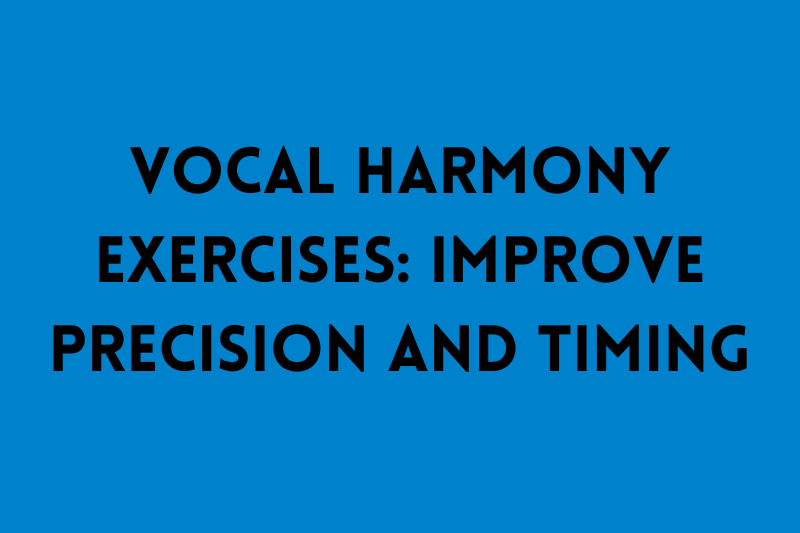Singing in harmony is one of the most beautiful experiences in music. When voices blend together perfectly, they create an emotional depth that moves the listener and elevates the performance. However, achieving that level of harmony doesn’t happen by chance it takes practice, awareness, and control.
If you’ve ever wondered how professional singers make harmony sound effortless, the secret lies in consistent training. Using effective harmony exercises can help improve your timing, balance, and ear coordination so you can sing confidently with others.
Let’s explore the best ways to strengthen your harmonizing skills and achieve clear, professional results.
1. Understanding the Foundation of Vocal Harmony
Harmony happens when two or more notes are sung together to create a fuller sound. In most songs, one voice carries the melody while others add supporting notes that enrich it. The relationship between these notes called intervals is what gives harmony its emotional power.
To start improving your harmonies, focus on learning how different intervals sound and feel. You can begin with simple pairs such as thirds, fifths, and octaves, and then move to more complex ones like sixths and sevenths. Training your ear to recognize these differences is the first step toward perfect vocal coordination.
Listening to your favorite artists and identifying where harmonies appear in their songs also helps build awareness. Active listening is key for developing your sense of pitch accuracy and tone blending.
2. Ear Training and Interval Recognition
Your ear is your most valuable instrument when it comes to harmony. One effective way to train it is by singing along with recorded harmonies or playing intervals on a keyboard or tuner.
Start by humming a melody and then find a note that sounds pleasant with it that’s a harmony. Continue experimenting until you can identify which interval you’re using by ear. Over time, this habit helps you predict harmony lines naturally during performances.
You can also take guided lessons or follow structured vocal harmony tutorials online. These lessons can help you recognize harmonies faster and improve your ability to stay in tune, even when surrounded by other voices.
3. Breathing and Tone Control for Perfect Balance
Smooth, steady breath control is essential for precise harmony. When your airflow is uneven, your tone may waver, making it harder to stay in sync with others. Practice diaphragmatic breathing by expanding your ribs and abdomen instead of lifting your shoulders. This method gives you consistent airflow and supports your tone throughout each phrase.
In addition to breath, focus on tone balance. Listen to the lead singer and adjust your tone to complement theirs. If they sing softly, lighten your voice; if their tone is strong, increase your projection slightly. Matching tone and breath ensures a cohesive and polished harmony blend.
4. Timing and Listening in Group Singing
Timing can make or break a harmony. Even the smallest delay between voices can disrupt the flow. To strengthen your timing, try clapping or humming in sync with your group before adding lyrics.
During group rehearsals, listen more than you sing. Being aware of other voices around you helps you adjust naturally. Remember, harmony is about teamwork everyone should work toward blending as one rather than standing out individually.
Recording your practice sessions also helps you spot inconsistencies and fine-tune your synchronization.
5. Layering and Advanced Harmony Exercises
Once you’re comfortable with basic harmonies, move on to layering exercises. Start by recording yourself singing the melody, then add a harmony line above or below it. Repeat this process until you can clearly hear how your voice interacts with others.
Another great practice is alternating between harmony and melody. This strengthens flexibility and keeps your ear sharp during live performances. As you gain control, experiment with more complex intervals and dynamic changes to make your harmonies sound more expressive.
6. Common Harmony Challenges and Fixes
Even experienced singers face difficulties when harmonizing. Here are some common problems and how to fix them:
-
Going off pitch: Practice slow and controlled harmony intervals with a tuner or piano.
-
Overpowering others: Adjust your volume to blend, not dominate.
-
Inconsistent tone: Record and analyze your blend to find the ideal tone balance.
-
Unclear vowels: Match vowel shapes across voices for smoother resonance.
These small details can greatly improve your overall harmony sound.
7. Applying Harmony in Real Songs
Once you’ve built a solid foundation, apply your skills in real songs. Choose tracks that feature clear harmonies and try to replicate them. Start slowly, then gradually increase tempo while maintaining accuracy.
During live performances, position yourself so you can hear others clearly. Use breath control and soft dynamics to keep your harmonies balanced. In studio recordings, experiment with microphone placement to achieve a richer, more even blend.
Conclusion
Perfecting harmony takes time and patience, but the results are worth every effort. Regular harmony exercises strengthen your pitch precision, timing, and teamwork skills. The more you practice, the easier it becomes to blend voices naturally and express emotion through music.
Whether you’re rehearsing in a choir, band, or acapella group, mastering harmony helps you grow as both a singer and a listener. Keep training your ear, refining your tone, and breathing with control and soon, your harmonies will sound as beautiful and seamless as any professional performance.


